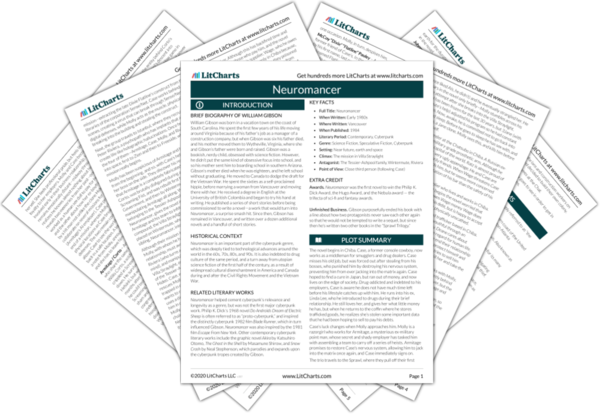Brief Biography of William Gibson
William Gibson was born in a vacation town on the coast of South Carolina. He spent the first few years of his life moving around Virginia because of his father’s job as a manager of a construction company, but when Gibson was six his father died, and his mother moved them to Wytheville, Virginia, where she and Gibson’s father were born and raised. Gibson was a bookish child, obsessed with science fiction. However, he didn’t put the same kind of obsessive focus into school, and so his mother sent him to boarding school in southern Arizona. Gibson’s mother died when he was eighteen, and he left school without graduating. He moved to Canada to dodge the draft for the Vietnam War. He spent the sixties as a self-proclaimed hippie, before marrying a woman from Vancouver and moving there with her. He received a degree in English at the University of British Columbia and began to try his hand at writing. He published a series of short stories before being commissioned to write a novel—a work that would turn into Neuromancer, a surprise smash hit. Since then, Gibson has remained in Vancouver, and written over a dozen additional novels and a handful of short stories.
Historical Context of Neuromancer
Neuromancer is an important part of the cyberpunk genre, which was deeply tied to technological advances around the world in the 60s, 70s, 80s, and 90s. It is also indebted to drug culture of the same period, and a turn away from utopian science fiction of the first half of the century, as a result of widespread cultural disenchantment in America and Canada during and after the Civil Rights Movement and the Vietnam War.
Other Books Related to Neuromancer
Neuromancer helped cement cyberpunk’s relevance and longevity as a genre, but was not the first major cyberpunk work. Philip K. Dick’s 1968 novel Do Androids Dream of Electric Sheep is often referred to as “proto-cyberpunk,” and inspired the distinctly cyberpunk 1982 film Blade Runner. When Gibson saw Blade Runner, he worried that Neuromancer (then a work-in-progress) overlapped too much with the film and consequently rewrote portions of the book multiple times. Neuromancer was also inspired by the 1981 film Escape From New York. Other contemporary cyberpunk literary works include the graphic novel Akira by Katsuhiro Otomo, The Ghost in the Shell by Masamune Shirow, and Snow Crash by Neal Stephenson, which parodies and expands upon the cyberpunk tropes created by Gibson.
Key Facts about Neuromancer
-
Full Title: Neuromancer
-
When Written: Early 1980s
-
Where Written: Vancouver
-
When Published: 1984
-
Literary Period: Contemporary, Cyberpunk
-
Genre: Science Fiction, Speculative Fiction, Cyberpunk
-
Setting: Near future, earth and space
-
Climax: The mission in Villa Straylight
-
Antagonist: The Tessier-Ashpool family, Wintermute, Riviera
-
Point of View: Close third person (following Case)
Extra Credit for Neuromancer
